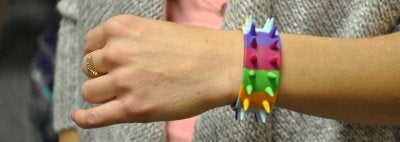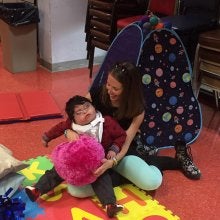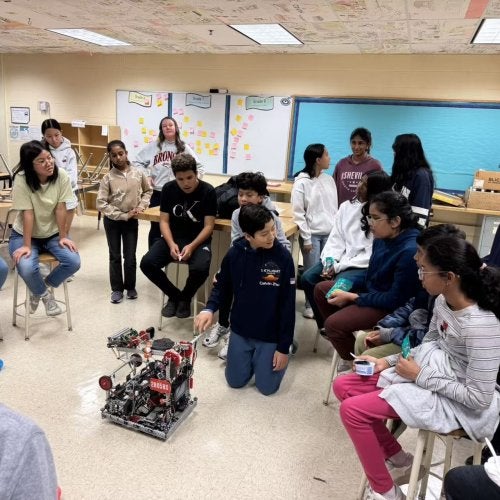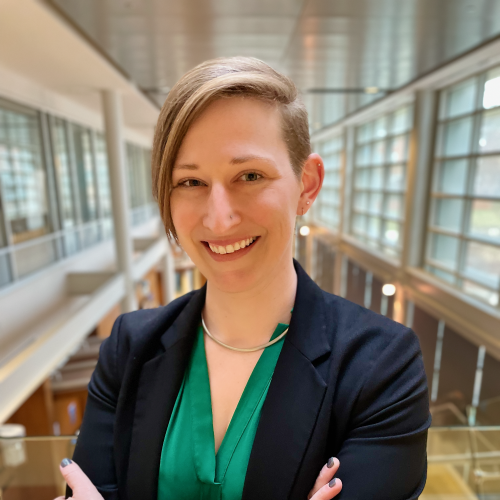

To Educate Deaf-Blind Children, Willis Joins Sight and Sound

Jennifer Willis began her college career with dreams of the stage.
“I was a musical theater major my first year of college and that didn’t work out so well,” she laughed. “I realized I enjoyed acting and performing, but I didn’t like learning about it.”
She’d completed her high school community service hours volunteering at a school for the deaf-blind, chosen because it “was something my mom could drive me to,” and Towson University had a deaf studies program, so she switched her course of study.
“I loved working with that type of kids,” she said. “I never wanted to be a teacher of typically developing kids. Seeing the innocence of this type of population—every little thing is progress for them. I just wanted to be a part of that. I enjoy learning about special education, which motivates me to constantly want to learn more to do better.”
After undergrad, Willis earned a master’s degree in deaf education at McDaniel University, and went on to teach at Maryland School for the Deaf. In August 2017, she joined Connections Beyond Sight and Sound: The Maryland and D.C. Deaf Blind Project at the University of Maryland in the role of project coordinator.

According to Project Director Donna Riccobono, there are about 200 children in Maryland and 20 in the District of Columbia who have a combination of visual and auditory disabilities.
“Our mission is to improve child outcome around collaboration and family support,” Riccobono said. Because of the rarity of the condition, however, finding teachers who are properly trained is an ongoing challenge. At present, there is not a specialized certification for teachers of the deaf-blind.
“We need someone who understands the importance of both senses and the impact of both senses, and how it affects development and learning,” said Jeni Smith Stepanek, education & technical assistance specialist. “It’s not just taking deaf strategies and blind strategies and using a little of each.”
The tactics employed, she added, “will impact how a child will connect with their world.”
Willis described, for example, going to visit the home of a deaf-blind child. “When you arrive at a typical person’s house,” she said, “they hear the doorbell. They see you. They hear your voice.”
With students who lack visual and auditory abilities, Willis relies on tactile symbols—things that can be felt—to create a sense of recognition. She wears a distinctive spiky rubber bracelet that allows the child to identify her.
The home visits, she said, are centered around the family’s needs—helping them navigate services and resources, and helping them engage with the child. Willis’s new position allows her to help even more children and families.
One of the primary goals of Connections Beyond Sight and Sound is to “try to unlock the box of [the student’s] potential,” said Riccobono. How are the students communicating? What is their communication system?
“We cannot continue to teach new concepts and skills if we don’t have a communication system. It’s very important that we follow the child’s lead,” she said.
Because of the challenges in communication, a trained professional, called an intervener, acts as a critical “bridge” between the child and their environment. Currently, efforts are underway to have intervention recognized as an official related service under the Individuals with Disabilities Education Act.
“Interveners are absolutely necessary for the education of these students,” Riccobono said.
Interveners are an essential element of helping deaf-blind children move toward a life that is more integrated with broader society and access meaningful education.
“Deaf-blindness is so low-incidence,” said Willis. “A lot of education institutions don’t know how to educate these kids. Just a deaf classroom or just a blind classroom doesn’t work. That’s when the intervener comes into play. That person knows how to help [the child] access their world and the people around them. [The intervener] knows how to help them learn language and become a successful individual.”
In the upcoming months, they are planning a series of workshops on special topics “to continue to provide ongoing quality training to families and professionals around children and youth with dual sensory challenges,” Riccobono said.
Goals include building capacity for more deaf-blind students in local schools, as well as ongoing training on communication matrices, building language foundations, and cooperative teaching of children, families and professionals together.”
“Our goal is to be able to support these kids in whatever way they need, and to be able to support them in all settings,” said Willis.
The staff of Connections Beyond Sight and Sound, including Willis, Riccobono, Stepanek and Dr. Sandy Newcomb, are all faculty and staff members in COE’s Department of Counseling, Higher Education, and Special Education.
Photo caption, top-left and left: At a Connections Beyond Site and Sound event held for students in the program and their families, Willis interacts with children who have hearing and vision challenges. In collaboration with the organization Go Baby Go, the event was held in order to build adapted ride-on cars for children with mobility issues.
This article originally appeared in the Winter 2018 issue of Endeavors, the College of Education's alumni magazine.


